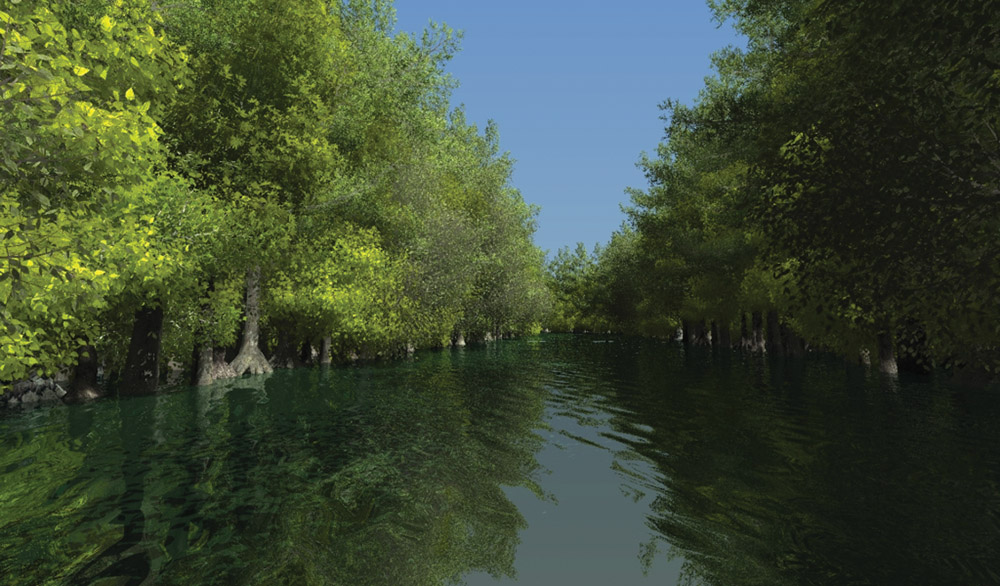Real-Time Research
by Frank Stephenson
 Rolling on the river
Rolling on the riverThis idyllic, if synthetic, river scene was drawn by computer graphics specialist Jay Steele, a recent graduate of Clemson’s computer graphics doctoral program. The image developed from Steele’s help on an NSF-funded project aimed at designing tools to model river basins. Steele now works as a senior software engineer at Walt Disney Animation Studios in Burbank, California.
What helped make the Oscar-winning Life of Pi one of the top-grossing films of 2012 was the film’s hairy star—a captivating Bengal tiger whimsically named Richard Parker. Lost on most spellbound viewers of Pi is the fact that Richard’s performance, instead of being a tour de force of animal training, is a stunning example of highly trained mathematics.
Behind almost every exciting frame of the two-hour film lies an invisible sea of cavorting numbers, a digital soup of algorithms that express themselves in breathtakingly realistic scenes that defy quick distinctions between the real and the unreal. Not a single frame of Richard Parker comes directly from a camera; nor does much of the ocean on which he floats for more than half the film.
Such is the state of visual effects (VFX) mastery today, a field that has vaulted from a trifling pastime among computer geeks in the 1970s to the dominant force in cinematic entertainment the world over. The sheer command that VFX has over what we see—and increasingly, how we interpret what we see—is, pure and simple, a triumph in computer graphics research.
Visual effects that serve science
At Clemson, such research has for years stood as one of the School of Computing’s most robust components. The school’s Visual Computing Division, led by seven researchers, is a training ground for students seeking Ph.D-level research careers in computer graphics, visualization, animation, and related computer-based techniques, all of which are primarily aimed toward a central goal: rendering what we see in nature into bits and bytes of digital information that can be more easily studied, understood, and used by scientists and engineers.
Most of the Visual Computing Division’s research is tied to what’s going on in the school’s Digital Production Arts program, says Robert Geist, professor of computing at Clemson since 1984. Even though the DPA program isn’t specifically geared to research (its top degree is a master’s in fine arts), Geist calls the program “the catalyst for most, perhaps all, of the computer graphics research at Clemson.” Geist cofounded the DPA program in 1998 with Clemson art professor Sam Wang, now retired.
In truth, the DPA program and the school’s doctorate-track research programs are joined at the hip, Geist said. For one thing, almost all the research in computer graphics at the school is funded by external grants (the National Science Foundation being the largest source), and most of these projects come with assistantships that are tailor-made for students with the kind of skills demanded by the DPA program. Students routinely get opportunities to work closely with Clemson researchers on a variety of projects, and are paid for it, Geist says.
As just one example, Geist cites a $3 million, NSF-funded project, led by his colleague Jason Hallstrom, that includes Geist and Jerry Tessendorf as coinvestigators. The project’s goal is to develop a tool that scientists can use to model the behavior of river basins. In nature, river basins are vastly complicated ecosystems that are constantly changing thanks to such variables as rainfall, forest fires, and human demands on water supplies. DPA students and doctoral students work on the model.
Tools of the trade
Then there’s all the coursework—at times it’s hard to tell doctoral from master’s students, Geist says. “We have lots of overlap between the coursework required for our doctoral program and that for the DPA. It’s therefore not uncommon for some of our DPA graduates to realize that research is what they really love, and they choose to pursue a doctorate here.”
A big step forward for Clemson’s national profile in computer graphics research occurred in August 2010. The Santa Clara, California-based company NVIDIA, a world leader in visual and high-performance computing, designated the university as a center for conducting highly specialized research into what is known as CUDA technology. The work focuses on building tools that render a host of natural phenomena from the growth of plants and animals to the flow of air and water in real time.
The application of such tools reaches far beyond Hollywood, of course. Already they’re revolutionizing the medical field, for example. The real-time simulation of blood flow is seen as a major weapon in the fight against heart disease. Meanwhile, a rapidly developing field known as nanoscale molecular dynamics, which depends almost entirely on real-time computer graphics, shows increasing promise for advances in biomedicine.
“The applications are endless,” Geist says.


